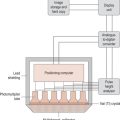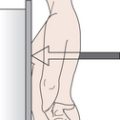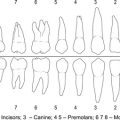E
ear the sensory organ concerned with hearing and balance. It has three parts, the outer (external), middle (tympanic cavity) and inner (internal) ear. The outer ear comprises the auricle (pinna) and the external auditory canal along which sound waves pass to vibrate the tympanic membrane which separates it from the middle ear. The middle ear cavity is air-filled and contains three tiny bones or ossicles: malleus, incus and stapes. The ossicles transmit the sound waves to the inner ear via the oval window. The middle ear communicates with the nasopharynx via the eustachian tube (pharyngotympanic tube). The fluid-filled inner ear comprises the cochlea (organ of hearing) and the semicircular canals which are concerned with balance. The cochlea and semicircular canals contain the nerve endings of the cochlear and vestibular branches of the vestibulocochlear or auditory nerve (eighth cranial). See also cerumen, cochlea.
eardrum the tympanic membrane at the end of the external auditory canal. The first auditory ossicle is attached to the inner surface.
eating disorders a term used to describe the range of conditions in which an individual’s eating behaviour and nutrient intake is inappropriate for their needs. anorexia nervosa is characterized by distorted body image and a deliberate restriction of food intake, resulting in severe weight loss, malnutrition, endocrine disorders and electrolyte disturbances. bulimia nervosa – body weight is controlled by periods of restricted eating, purging and binge eating. Weight usually remains stable and within normal range. binge eating disorder – periods of binge eating without periods of food restriction or purging which result in the development of obesity. A complex mixture of social and psychological factors and life events predispose to and precipitate the development of eating disorders. Consequently they are best treated by a multidisciplinary team.
ecchondroma a benign tumour composed of cartilage which protrudes from the surface of the bone in which it arises.
eccrine the most abundant type of sweat gland. See also apocrine glands.
echo the reflection of an ultrasound wave back to the transducer when the beam hits a surface at right angles.
echocardiography the use of ultrasound as a diagnostic tool for studying the structure and motion of the heart.
echoencephalography passage of ultrasound waves across the head. Can detect abscess, blood clot, injury or tumour within the brain.
echogenicity a characteristic of an ultrasound image, for example, benign masses are often homogeneous and malignant masses are often heterogeneous or fluid is black and solid areas appear white.
echo rephrasing the re-establishment of a magnetic resonance signal by either using a 180°radio frequency pulse or by gradient switching.
echo time (TE) the time between the centre of the excitation pulse and the peak of the echo.
echo train length the number of echoes that are individually phase encoded for a fast spin-echo sequence and corresponds to the number of lines of k-space measured per repetition time interval, they range from 3 to 128 depending on the type of pulse sequence. See also k-space, repetition time.
eclampsia occurrence of convulsions in a pregnant woman with signs of pre-eclampsia. A sudden convulsive attack.
ecmnesia impaired memory for recent events with normal memory of remote ones. Common in old age and in early cerebral deterioration.
ecological study a research study where a particular group of individuals rather than an individual, for example, schools, towns, etc., form the unit being observed.
economy describes spending or using as little as possible while still maintaining quality.
ectoderm the outer of the three primary germ layers of the early embryo. It gives rise to some epithelial and nervous tissues, for example, skin structures, inner ear, mammary glands, pituitary gland, the central nervous system, cranial, spinal and autonomic nerves, adrenal medulla and the lens and retina. See also endoderm, mesoderm.
ectogenesis (in vitro fertilization) the growth of the embryo outside the uterus.
ectopia malposition of an organ or structure, usually congenital.
ectopia vesicae an abnormally placed urinary bladder which protrudes through or opens on to the abdominal wall.
ectopic beat see extrasystole.
ectopic pregnancy (tubal pregnancy) pregnancy outside the womb (extra-uterine gestation), the uterine (fallopian) tube being the most common site.
ectrodactyly, ectrodactylia congenital absence of one or more fingers or toes or parts of them.
eczema an inflammatory skin reaction that may begin with erythema, then vesicles appear. These rupture, forming exudative areas that may crust. Scaling may occur. In chronic forms the skin becomes thickened. Some authorities limit the word ‘eczema’ to the cases with internal (endogenous) causes while those caused by external (exogenous) contact factors are called dermatitis. The skin of patients with eczema may be colonized or infected with Staphylococcus aureus. See also dermatitis.
eddy currents are induced electric currents in a transformer core and oppose the direction of the current in the windings of a transformer resulting in a power loss in the transformer, they can be reduced by laminating the core. In magnetic resonance imaging they are induced in the gradient coils or the structure of the magnet and degrade the image unless compensated for or eliminated.
edentulous without natural teeth.
editing altering a text or computer program.
effective current the value of current flowing for the same time that would produce the same electrical energy in a circuit as the equivalent alternating current.
effective dose a calculation to determine that amount of radiation received by a patient, for radiation protection purposes, which is weighted for each organ because different organs in the body show different sensitivity to radiation. The amount of a drug that can be expected to initiate a specific intensity of effect in people taking the drug.
effective half-life the time taken for the activity of a radionuclide in an organ to be reduced to half its original activity.
effective photon energy the energy of a homogeneous beam of photons having the same half value layer as the X-ray beam being evaluated.
effectiveness describes using resources to achieve the required outcomes.
effective voltage the value of voltage flowing for the same time that would produce the same electrical energy in a circuit as the equivalent alternating voltage.
effector a motor or secretory nerve ending in a muscle, gland or organ.
efferent carrying, conveying, conducting away from a centre. See also afferent.
efferent nerve one which conveys impulses outwards from the central nervous system to the muscles and glands. Also known as motor nerves.
effervescent material used in radiotherapy to make an immobilizing device by placing the patient on an empty polythene bag, introducing the self hardening material and producing an impression of the patient’s position, the impression can then be used during treatment to exactly replicate the patient position.
efficiency describes the use of minimum resources to achieve the maximum outcomes.
effusion extravasation of fluid into body tissues or cavities, such as a pleural effusion, or into joints where it causes swelling.
ejaculation sudden emission of semen from the penis at the moment of male orgasm. retrograde ejaculation a situation where semen is discharged backwards into the bladder. It may follow prostate surgery or be associated with diabetic neuropathy.
elastic collisions the mutual attraction of atoms, molecules etc. when the total energy is unchanged after the collision.
elastic scattering when a photon interacts with an electron, is deflected from its path but does not lose energy. See also coherent scattering.
elbow joint a synovial hinge joint formed by the humerus, radius and ulna.
elder abuse physical, sexual, psychological, pharmacological or financial abuse of older people. May be by family, neighbours or carers.
electric circuit the diagrammatic representation of electron flow through an electrical device.
Symbol and function of electric circuit elementsa
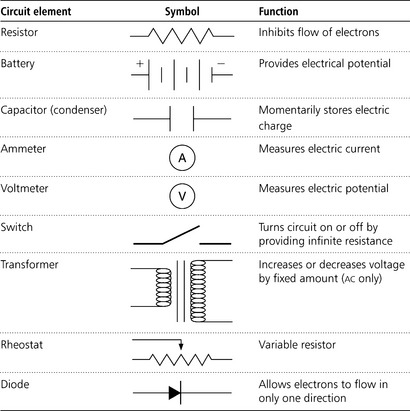 |
a From Radiologic science for technologists, 8th edn, 2005, S C Bushlong, Mosby, St Louis, with permission.
electric current the rate of flow of electrons in a material. An electric current of one ampere flows at a point if a charge of one coulomb flows past the point per second.
electric field the area surrounding an electrical charge, if an electric charge is placed inside the field a noticeable force will be exerted on it.
electrical potential at a point is the measure of the work required to bring a unit positive charge from infinity to that point.
electric shock shock caused when an electric current passes through the body, usually caused by accidental contact with an electric supply.
electrocardiogram (ECG) a recording of the electrical activity of the heart muscle during the cardiac cycle made by an electrocardiograph. The normal heart produces a typical waveform, sinus rhythm, which consists of five deflection waves, known universally as PQRST. See also ambulatory ECG, exercise (stress) ECG.
electrocardiograph an instrument that records the electrical activity of the heart from electrodes on the limbs and chest.
electrode in medicine or therapy, a conductor in the form of a pad or plate, whereby electricity enters or leaves the body.
electroencephalogram (EEG) a recording of the electrical activity of the brain, made by an electroencephalograph.
electroencephalograph an instrument by which electrical impulses derived from the brain can be amplified and recorded, in a fashion similar to that of the electrocardiograph.
electrolysis chemical decomposition by electricity, with ion movement shown by changes at the electrodes. Term used for the destruction of individual hairs (epilation), removal of moles, spider naevi, etc., using electricity.
electrolyte a solution of a substance, such as sodium chloride, which dissociates into ions with an electrical charge (anions, cations). In medicine it describes the individual ion, for example, potassium and bicarbonate ions in the body. electrolyte balance the balance of relative amounts of electrolytes, for example, potassium, sodium, magnesium, calcium, chloride, bicarbonate (hydrogen carbonate) and phosphate in blood, other fluids and tissues. The balance between ions with a positive charge and those with a negative charge ensures overall electrical neutrality in the body. Many conditions and diseases cause electrolyte imbalance, which is often associated with loss of fluid and pH homeostasis.
electrolytic recovery a method for recovering silver from radiographic fixer solution using a carbon anode and a stainless steel cathode, a direct current is passed between the two and the positively charged silver ions are attracted to the cathode where they are neutralized and form metallic silver, either a low or a high current density is used.
electromagnet is formed when a piece of soft iron is placed inside a solenoid resulting in induced magnetism within the iron bar.
electromagnetic radiation waves of energy that are caused by the acceleration of charged particles.
electromagnetic spectrum the ordering of electromagnetic radiation into the various wavelengths and frequencies.
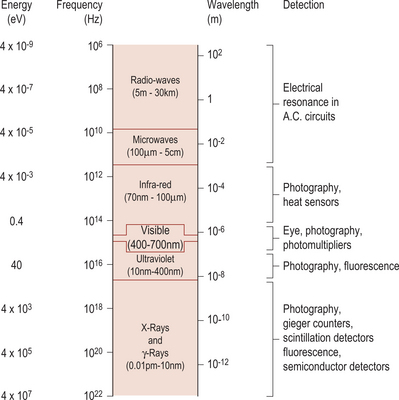
The electromagnetic spectrum (not drawn to scale).
From Principles of radiological physics, 3rd edn, D T Graham, 1996, Churchill Livingstone, Edinburgh, with permission.
electromotive force (EMF) measures the force needed for an electric current to flow between two points. A derived SI unit (International System of Units), the volt (V), is used.
electron a negatively charged subatomic particle.
electron capture the capture of an electron by the nucleus of an atom, the electron combines with a proton to form a neutron and a neutrino which is ejected from the nucleus.
electron gun a piece of equipment that produces electrons by heating a spiral filament and then focussing them to form an electron beam.
electron microscopy the use of a beam of electrons to visualize very small structures, such as virus particles.
electron shells the orbits round the nucleus of an atom where the electrons are found in discrete levels, K is the nearest orbit to the nucleus and they are then labelled M, N, O, P etc.
electron transfer chain a series of mitochondrial oxidation-reduction reactions that generate cellular energy as ATP.
electron trap an area of low energy within a crystal which has the ability to catch and hold an electron for a period of time before it acquires the energy to escape.
electronic callipers a method of measurement used to calculate the distance between two points identified during ultrasound imaging.
electronic collimation used in PET cameras when an image is only recorded when two detectors simultaneously detect a photon of energy. See also positron-emission tomography.
electronic health record a computerized summary of a patient’s health record showing all their interactions with general practitioners and community healthcare workers.
electronic patient record a computerized summary of all a patient’s healthcare both in a primary and secondary care setting including written records, test results and medical images, for example, radiographs, scans, photographs, etc.
electronic portal imaging (EPI) a method of capturing an image digitally in real time and the image is superimposed on the original radiotherapy simulation film or image to verify the accuracy of the field placement.
electrophoresis a technique where charged particles are separated in a liquid medium by their characteristic speed and direction of migration in an electrical field. Used for measuring serum proteins.
element a substance that cannot be broken down by chemical means into any other substance, each atom in the element contains a specific number of protons in the nucleus, a variable number of neutrons in the nucleus and a given number of electrons outside the nucleus. One of the constituents of a compound. The elements are the primary substances which in pure form, or in combinations as compounds, constitute all matter.
elevation an upward movement such as the scapulae when the shoulders are lifted.
elimination the passage of waste from the body – urine and faeces.
ellipsoid joint a synovial joint that allows flexion, extension, abduction and adduction, for example, wrist joint.
eluting solution a liquid used to remove another substance by washing, used in a technetium generator where the eluting solution, saline, washes out the pertechnetate as sodium pertechnetate solution.
emaciation excessive leanness, or wasting of body tissue.
email an electronic mail system. Its current uses include sending imaging reports and pathology reports directly to GP surgeries from one computer to another via Healthlink. It may also be used by GPs for the direct referral of patients for examinations.
embolization the method of stopping, or drastically reducing the flow of blood in a vessel.
embolism obstruction of a blood vessel usually caused by a thrombus blood clot, but other causes include cancer cells, fat, amniotic fluid, gases, bacteria and parasites. Rarer emboli, such as fat, may follow long bone fractures, air may enter the circulation via a penetrating chest wound or during surgery, and amniotic fluid during labour. arterial embolism, originating from the left side of the heart or arterial disease, may travel to various sites including brain, bowel or limb; the effects dependent on the size of vessel affected and site, for example, gangrene of a limb or a portion of bowel. See also cerebrovascular accident, deep vein thrombosis, pulmonary embolism.
embolization therapeutic occlusion of a blood vessel using a foreign substance.
embolus solid body, for example a clot, or a gas bubble transported in the circulation. See also embolism.
embryo developmental stage starting 2 weeks after fertilization until the end of week 8 of gestation.
embryology study of embryonic development.
embryopathy abnormality or disease of the embryo.
emetic any agent used to produce vomiting.
emetogenic term that describes substances that cause vomiting or may do so, for example, cancer chemotherapy.
emission to send out. In physics all bodies emit electromagnetic radiation but a black body is the most efficient. In an intensifying screen when the light photons leave the screen and expose the film emulsion. An ejaculation or sending forth, especially an involuntary ejaculation of semen.
emphysema gaseous distension of the tissues. See also crepitation, pulmonary emphysema, surgical emphysema.
empirical based on observation rather than on scientific reasoning.
empyema pus in the pleural cavity.
emulsion is the part of a radiographic film formed by light-sensitive salts for example silver halides in a gelatine binder, that records the radiographic image.
enamel the outer layer covering the crown of a tooth.
encapsulation enclosure within a capsule.
encephalitis inflammation of the brain.
encephalocele protrusion of brain substance through the skull. Often associated with hydrocephalus when the protrusion occurs at a suture line.
encephalography a general term for techniques used to examine the brain. See also echoencephalography, electroencephalography, pneumoencephalography.
encephalomalacia softening of the brain.
encephalomyelitis inflammation of the brain and spinal cord.
encephalomyelopathy disease affecting both brain and spinal cord.
encephalopathy any disease of the brain causing reduced levels of arousal and cognitive function.
enchondroma a cartilaginous tumour.
encryption a method of encoding computer data to prevent unauthorized people having access to the information.
endarteritis inflammation of the intima or inner lining coat of an artery. endarteritis obliterans the new intimal connective tissue obliterates the lumen.
endemiology the special study of endemic diseases.
endobronchial tube plastic double-lumen tube introduced via the mouth into either of the two main bronchi in thoracic anaesthesia.
endocarditis inflammation of the inner lining of the heart (endocardium) due to infection by microorganisms (bacteria, fungi or Rickettsia), or to rheumatic fever. There may be temporary or permanent damage to the heart valves.
endocardium the smooth endothelium that lines the heart and covers the valves.
endocervical associated with the inside of the cervix uteri.
endocrine secreting internally. See also exocrine.
endocrine glands the ductless glands that produce a hormone which passes directly into the blood or lymph. They include the hypothalamus, pineal body, pituitary, thyroid, parathyroids, adrenals, ovaries, testes and pancreas. Other structures also produce hormones, for example, placenta, gastrointestinal tract, kidneys and the heart.
endoderm inner layer of the three primary germ layers of the early embryo. It gives rise to some epithelial tissue, for example, that of the pharynx, middle ear, respiratory tract, gastrointestinal tract and bladder. See also ectoderm, mesoderm.
endodontics branch of dentistry concerned with the diagnosis and treatment of diseases of the dental pulp and periapical tissues.
endogenous originating within the organism. See also exogenous.
endolymph the fluid within the membranous labyrinth of the internal ear.
endometrial associated with the endometrium. endometrial destruction transcervical destruction of the basal layer of the endometrium by transcervical resection, laser ablation or by using heat. Used in suitable cases as an alternative to hysterectomy in the treatment of menorrhagia.
endometrioma a tumour of misplaced endometrium.
endometriosis the presence of endometrium in abnormal sites, i.e. outside the uterus.
endometritis inflammation of the endometrium.
endometrium the specialized lining mucosa of the uterus.
endomyocardial relating to the endocardium and myocardium.
endomysium thin, inner connective tissue surrounding the muscle fibres.
endoneurium the delicate, inner connective tissue surrounding the nerve fibres.
endorphins a group of opioid-like neuropeptides. They are active in both central and peripheral nervous functions where they modulate pain interpretation and induce feelings of euphoria. See also enkephalins.
endoscope an instrument for visualization of the interior of hollow tubular structures such as the urinary and gastrointestinal tracts, or body cavities, for example, joints. The older ones were rigid, tubular and made of metal. Those in general use are of the fibreoptic variety: light is transmitted by means of very fine glass fibres along a flexible tube. It permits examination, photography, biopsy and treatment of the cavities or organs of a relaxed (sedated) conscious person.
endoscopic retrograde cholangiopancreatography (ERCP) introduction of an opaque contrast agent into the pancreatic and bile ducts via a catheter from an endoscope located in the duodenum.
endothelioid resembling endothelium.
endothelioma a tumour derived from endothelial cells.
endothelium the lining membrane of serous cavities, heart, blood and lymph vessels.
endotracheal within the trachea. endotracheal anaesthesia the administration of an anaesthetic through an endotracheal tube.
endotracheal tube a plastic tube introduced via the nose or mouth into the trachea to maintain an airway during general anaesthesia and intermittent positive pressure ventilation.
enema the introduction of a liquid into the bowel via the rectum, to be returned or retained. The word is usually preceded by the name of the liquid used. It can be further designated according to the function of the fluid. The evacuant enemas are usually prepared commercially in small bulk as a disposable enema: the chemicals attract water into the bowel, promoting cleansing and peristaltic contractions of the lower bowel. The enemas to be retained are usually drugs, the most common being corticosteroids. See also barium enema, laxatives.
energy conservation techniques, including time management, problem solving and lifestyle planning, that enable an individual to make the best possible use of limited energy reserves. Commonly used in occupational therapy practice.
energy resolution the ability to distinguish between two different energy values. In a gamma camera, the width of the absorption peak at half the maximum count rate observed at the peak.
enhanced CT the use of a contrast agent to demonstrate more clearly vessels or organs of similar density to the surrounding tissue.
enkephalins (encephalins) neurotransmitters present in the central nervous system, pituitary gland and gastrointestinal tract. They have opioid-like analgesic effects. See also endorphins.
enophthalmos sunken position of an eyeball within its socket.
ensiform sword-shaped; xiphoid.
enteral within the gastrointestinal tract.
enteral diets those which are taken by mouth or through a nasogastric tube; low-residue enteral diets can be whole protein/polymeric, or amino acid/peptide.
enteral feeding method of providing nutrition when the gastrointestinal tract is functioning. Includes via nasogastric and nasoduodenal tubes or via gastrostomy or jejunostomy tubes. Enteral feeding can be administered by bolus, gravity or pump-controlled methods. See also parenteral feeding, percutaneous endoscopic gastrostomy (PEG).
enteric relating to the small intestine.
enteric coating a coating applied to a pill that prevents drug release until it reaches the small intestine.
enteric fevers includes typhoid and paratyphoid fever.
enteritis inflammation of the intestine.
Enterobius vermicularis (threadworm) nematode which infests the small and large intestine.
enterocele prolapse of intestine. Can be into the upper third of vagina.
Enterococcus a genus of Gram-positive cocci commensal in the bowel, for example, Enterococcus faecalis, E. faecium. They cause urinary tract infection and wound infection and occasionally meningitis in neonates. It is increasingly common as a cause of hospital-acquired infection, and many strains are developing resistance to antibiotics.
enterokinase (enteropeptidase) a proteolytic enzyme produced by duodenal mucosa. It converts inactive trypsinogen (pancreatic enzyme) into active trypsin.
enteropeptidase see enterokinase.
enterovesical associated with the bowel and the bladder.
Entonox proprietary name for a gaseous mixture of oxygen and nitrous oxide in equal measures that is inhaled by the patient to provide analgesia, for example, in obstetrics and intensive care.
entrance maze a structure to prevent primary radiation and first scattered photons reaching the room door, used in radiotherapy treatment rooms so that lighter doors can be used and darkrooms so that people can enter while a film is being processed.
enucleation removal of an organ or tumour in one piece. Removal of the eyeball due to malignant tumour, infection, trauma or control of pain in glaucoma.
| Coloured indicator lights (e.g. on a control desk) | |
| RED: | Warning of danger requiring urgent action to terminate an unintended state of operation |
| YELLOW: | Requiring attention, caution (e.g. radiation on) |
| YELLOW (flashing): | Sources in transit (e.g. in remote afterloading equipment) |
| GREEN: | Ready for action |
| WHITE: | Equipment switched on but further operations required to bring it to the ready state |
| Coloured cables (single phase mains) | |
| BROWN: | Live |
| BLUE: | Neutral |
| GREEN/YELLOW: | Earth |
| Coloured cables (three phase mains) | |
| BROWN/BLUE/YELLOW: | Three live phases |
| GREEN/YELLOW: | Earth |
a From Walter and Miller’s textbook of radiotherapy, 6th edn, 2003, C K Bomford and I H Kunkler (eds), Churchill Livingstone, Edinburgh, with permission.
enuresis incontinence of urine, especially bed-wetting. nocturnal enuresis bed wetting during sleep.
environmental monitoring a mechanism for ensuring that the protective barriers in departments provide a safe working environment for all staff and the general public.
enzyme a protein that functions as a catalyst for specific biochemical reactions involving specific substrates. Many reactions in the body would proceed too slowly without an enzyme, for example, waste carbon dioxide would not be removed from the tissues without the enzyme carbonic anhydrase. Enzyme names often reflect their function, for example, dehydrogenases catalyse the removal of hydrogen in oxidation reactions.
eosinophil cells having an affinity for eosin. A type of polymorphonuclear leucocyte containing eosin-staining granules, it is associated with immune responses that involve allergies and immunoglobulin (IgE).
eosinophilia increased number of eosinophils in the blood.
ependymal cells a type of neuroglial cell that lines the fluid-filled cavities of the central nervous system (cerebral ventricles and the central canal of the spinal cord).
ependymoma a tumour arising from the lining cells of the ventricles, central canal of the spinal cord and the filum terminale.
epicardium the visceral layer of the pericardium.
epicondyle an eminence on some bones situated above the condyles, for example, femoral epicondyles.
epicondylitis inflammation of the muscles and tendons around the elbow. Can occur if the structures are subjected to excess or repetitive stress. It may affect the structures at the lateral (outer) or medial (inner) aspect of the elbow. lateral epicondylitis (tennis elbow) is associated with tennis, other racquet sports and weight training. medial epicondylitis (golfer’s elbow) is primarily an overuse injury associated with golf and poor lifting techniques. See also bursitis.
epicritic describes cutaneous nerve fibres which are sensitive to fine variations of touch and vibration. Concerned with proprioception and two-point discrimination. See also protopathic.
epidemiology the scientific study of the distribution of diseases. It is concerned with the incidence, distribution and control of disease.
epidermis the outer avascular layer of the skin, the cuticle.
epididymis a small oblong body attached to the posterior surface of the testes. It consists of the seminiferous tubules which carry the spermatozoa from the testes to the deferent ducts (vas deferens).
epidural upon or external to the dura.
epidural anaesthesia local anaesthetic injected into the space external to the dura either by single injection or intermittently via a catheter, causing loss of sensation in an area determined by the site of the injection and volume of local anaesthetic used. epidural space the region through which spinal nerves leave the spinal cord. It can be approached at any level of the spine, but the administering of anaesthetic is commonly done at the lumbar level or through the sacral cornua for caudal epidural block.
epigastrium the abdominal region lying directly over the stomach.
epiglottis the thin leaf-shaped flap of cartilage behind the tongue which, during the act of swallowing, covers the opening leading into thelarynx.
epilepsy conditions resulting from disordered electrical activity in the brain resulting in epileptic seizures or ‘fits’. The seizure is caused by an abnormal electrical discharge that disturbs brain and results in a generalized or partial seizure, depending on the area of the brain involved. See also grand mal, petit mal, Jacksonian epilepsy, status epilepticus.
epileptic a person with epilepsy.
epileptic aura tingling in the hand or visual or auditory sensations that precede an attack of epilepsy. See also aura.
epimysium outer fibrous coat surrounding an entire muscle.
epineurium outer fibrous coat enclosing a nerve trunk.
epiphora the continuous weeping of the eye, often due to blockage of the lacrimal apparatus.
epiphysis the end of a growing bone. Separated from the shaft by the epiphyseal plate (cartilage) this is replaced with bone (ossification) when growth ceases.
episclera loose connective tissue between the sclera and conjunctiva.
epistaxis bleeding from the nose.
epithelialization the growth of epithelium over a raw area; the final stage of healing.
epithelioma a tumour arising from any epithelium.
epithelium one of the four basic tissues. It lines cavities, covers the body and forms glands. It is classified according to the arrangement and shape of the cells it contains. It may be simple, single layer of squamous, cuboidal or columnar, or stratified with many layers, for example, stratified or transitional.
EPROM (Erasable Programmable Read Only Memory) a memory store which can be programmed and then erased by UV light.
Epstein-Barr virus (EBV) a herpesvirus, the causative agent of infectious mononucleosis. Also linked with the formation of some malignant tumours, including Burkitt’s lymphoma and nasopharyngeal cancer.
epulis a tumour growing on or from the gums.
equinus a condition in which the toes point down and the person walks on tiptoe. See also talipes.
equity fairness of distribution of resources such as health care. Access to resources is based on need and the ability to benefit. The ability of a healthcare system to provide a comparable level of health care across the entire population. Covers the following dimensions: need for health care in the population (dependent on epidemiology of disease, determinants of health); availability, accessibility of healthcare resources; distribution of healthcare resources; use (utilization) of healthcare resources; geographic variation in need and healthcare utilization.
equivalent dose a unit of dose that allows for the fact that different types of radiation will deposit different types of energy depending on the specific mass and charge.
equivalent square a square which produces the same percentage scatter as an elongated or circular field, used to calculate depth dose in radiotherapy.
equivalent wavelength the quality of a radiation beam by calculating Planck’s constant times velocity over the maximum kilovoltage (Duane-Hunt’s law).
erasable optical disks (Magneto-optical disks or MO disks) read and write optical disks which combine magnetic and optical techniques.
Erb’s palsy paralysis involving the shoulder and arm muscles from a lesion of the fifth and sixth cervical nerve roots. The arm hangs loosely at the side with the forearm pronated (‘waiter’s tip position’). Most commonly a birth injury.
erectile upright; capable of being elevated.
erectile dysfunction an inability to achieve or maintain penile erection.
erectile tissue vascular tissue, which, under stimulus, becomes rigid and erect from hyperaemia.
erection the state accomplished when erectile tissue is hyperaemic.
erector a muscle which achieves erection of a part. erector spinae muscle of the back.
eruption the process by which a tooth emerges through the alveolar bone and gingiva.
erythema redness or inflammation of the skin, can be as a result of mild sunburn or reaction to radiotherapy treatment.
erythroblast a nucleated erythrocyte precursor found in the red bone marrow.
erythrocytes non-nucleated red cells of the circulating blood. They carry oxygen and some carbon dioxide, and buffer pH changes in the blood.
erythrocyte sedimentation rate (ESR) citrated blood is placed in a narrow tube. The red cells fall, leaving a column of clear supernatant serum, which is measured at the end of an hour and reported in millimetres. Inflammation and tissue destruction cause an elevation in the ESR.
erythrocytopenia deficiency in the number of red blood cells.
erythroderma abnormal redness of the skin, usually over a large area.
erythropoiesis the production of red blood cells by the bone marrow. See also erythropoietin, haemopoiesis.
erythropoietin a hormone secreted by some kidney cells in response to reduced oxygen content in the blood. It acts on the bone marrow, stimulating erythropoiesis. A recombinant human form is used therapeutically to treat anaemia associated with chronic renal failure and platinum-containing chemotherapy.
establishment describes the planned staffing levels in a particular area. Usually described as the number of whole time equivalents (WTEs).
ethernet a method of connecting a computer to a network to enable communication with other computers.
ethics a code of moral principles derived from a system of values and beliefs. It is concerned with rights and obligations. ethics committees bodies that operate in academic institutions and NHS Trusts to consider proposals for research projects. The approval of the appropriate ethics committee is usually a prerequisite for obtaining a research grant.
ethmoid a spongy bone forming the lateral walls of the nose and the upper portion of the bony nasal septum.
ethmoidal sinuses numerous small, irregular-shaped cavities in the ethmoid bone.
ethnography a study of individuals in their usual surroundings. Used in qualitative research by anthropologists to describe customs, culture and social life through observation, informal interviews, etc.
ethyl chloride a volatile liquid used to test the onset of regional anaesthesia by reason of the intense cold sensation produced when applied to the skin.
ethylene oxide a gas used to sterilize delicate equipment that would be damaged by high temperatures.
etoposide a chemotherapeutic agent and mitotic inhibitor.
eustachian tube see pharyngotympanic tube.
euthanasia literally an ‘easy death’. Inferring a painless death. Frequently interpreted as the act of causing a painless and planned death, such as relieving a person’s extreme suffering from an incurable disease. Presently illegal in UK and opposed by many professional groups, it is practised in some European countries.
evacuant an agent which initiates an evacuation, such as of the bowel. See also enema, laxatives.
evacuation the act of emptying a cavity; generally refers to the discharge of faecal matter from the rectum. See also manual evacuation.
evacuation of retained products of conception (ERPC) emptying the uterus following an incomplete miscarriage.
even echo rephrasing in magnetic resonance imaging, the re-establishment of spin-echo coherence of moving spins on symmetric even echoes in multiecho sequences as a result of sequential integration of signal phase shifts adding to zero.
evidence-based medicine (EBM) practice (EBP) describes the practice of medicine or delivery of healthcare interventions that are based on systematic analysis of information available in terms of effectiveness in relation to cost-effective health outcomes. The highest level of evidence (based on the robustness of the research methodology) is that gained from meta-analysis of randomized controlled trials (RCTs). Sometimes this level of evidence is not available and at the lowest level may be based on evidence from expert committee reports or opinions and/or clinical experience of respected practitioners.
evulsion forcible tearing away of a structure.
Ewing’s tumour a malignant tumour that develops from bone marrow, usually in the long bones or the pelvis. Usually diagnosed in a child or young adult.
excision removal of a part by cutting.
excision biopsy the cutting out of a lesion and surrounding normal tissue for examination.
excitation the process of moving an electron in an atom into a higher orbit.
excrescence an abnormal protuberance or growth of the tissues.
excreta the waste material that is normally cleared from the body, particularly urine and faeces.
excretion the elimination of waste material from the body, and also the eliminated material.
excretion urography the radiographic investigation of the kidneys, ureters and bladder following the injection of a contrast agent.
exercise (stress) ECG performed during increasing levels of exertion, such as on a treadmill, to detect arrhythmias or ischaemic changes caused by physical stress. Frequently used for the diagnosis or prognosis of heart disease or to guide cardiac rehabilitation.
exfoliation the scaling off of tissues in layers. The shedding of the primary teeth.
ex gratia as a matter of favour, for example, without admission of liability, of payment offered by a NHS Trust to a claimant.
exocrine describes glands from which the secretion passes via a duct; secreting externally. See also endocrine.
exogenous of external origin. See also endogenous.
exophytic tendency to grow outwards, such as a tumour that grows into the lumen of a hollow organ rather than into the wall.
exostosis an overgrowth of bone tissue forming a benign tumour.
expected date of delivery (EDD) usually calculated as 280 days from the first day of the last normal menstrual period.
experimental epidemiology the study of the effect of controlling the relevant suspected factors in the cause of a disease such as stopping cigarette smoking.
experimental group a research term that describes the group exposed to the independent variable (the intervention or experimental agent such as a drug). See also control group, variable.
expiration the process of breathing out air from the lungs.
expired air resuscitation forced introduction or air into the lungs of someone who has stopped breathing, it may be administered mouth to mouth, mouth to nose or by using ventilating equipment.
exponential law the decay or growth of a substance in which each step is half the value or double the value of the preceding step.
exposure the measure at a particular point in a beam of X or γ rays and is the total charge of one sign over a small volume of air, unit coulombs per kilogram, now replaced by the kerma.
exposure factors the settings used to produce the optimum radiographic image quality with the minimum radiation dose to the patient. The settings include the kilovoltage (kVp), milliamperes per second (mAs), source to image distance (SID), object to image distance (OID), source to object distance (SOD), the use of a secondary radiation grid, collimation and the type of film screen combination used. (See figure on p. 153.)
exposure rate the measure of the intensity of a beam in unit time.
extended focus-to-skin distance techniques radiotherapy treatment techniques where the focus to skin distance (FSD) is greater than 100 cm.
extension traction upon a fractured or dislocated limb. The straightening of a flexed limb or part.
extensor a muscle which on contraction extends or straightens a part.
external auditory meatus (auditory canal) the canal between the pinna and eardrum.
Exposure factors. In selecting the exposure factors for an examination the radiographer is attempting to produce an image of optimum quality but at minimum radiation dose to the patient. Below is a summary of some of the factors which might be changed and their direct and indirect effect(s) on image quality and radiation dose to the patienta
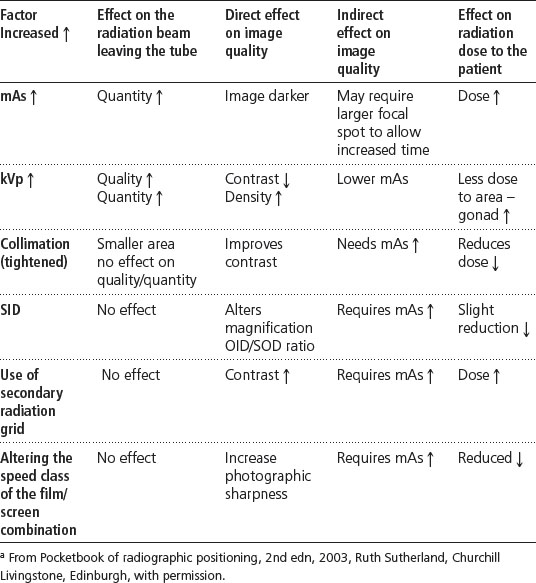
external haemorrhage bleeding when the skin surface is damaged.
external hydrocephalus excess of cerebrospinal fluid mainly in the subarachnoid space.
external respiration the exchange of gases between alveolar air and pulmonary capillary blood. Oxygen in the alveolar air moves into the blood, and carbon dioxide moves from the blood into the air in the lungs for excretion.
external rotation (lateral rotation) a limb or body movement where there is rotation away from the vertical axis of the body.
extra-articular outside a joint.
extracapsular outside a capsule.
extracardiac outside the heart.
extracellular outside the cell membrane.
extracellular fluid (ECF) fluid outside the cells such as plasma, interstitial fluid, lymph, gastrointestinal fluid and CSF. See also intracellular.
extracorporeal outside the body.
extracorporeal circulation blood is taken from the body, directed through a machine (‘heart-lung’ or ‘artificial kidney’) and returned to the general circulation. See also cardiac bypass, cardiopulmonary bypass, extracorporeal membrane oxygenation (ECMO), haemodialysis.
extracorporeal membrane oxygenation (ECMO) a cardiopulmonary bypass device which uses a membrane oxygenator (artificial lung). Venous blood from the patient circulates through the device by a roller pump. A fresh flow of oxygen into the device passes through a semipermeable membrane that allows the diffusion of oxygen while simultaneously removing carbon dioxide and water. Once the blood is oxygenated it is returned to the patient through an artery or a vein.
extraction the removal of a tooth.
extraction of lens surgical removal of the lens from the eye. It may be extracapsular extraction, when the capsule is ruptured prior to delivery of the lens and preserved in part, or intracapsular extraction, when the lens and capsule are removed intact.
extradural external to the dura mater.
extradural haematoma a collection of blood external to the dura mater.
extrahepatic outside the liver.
extrahepatic cholestasis caused by a blockage to a large duct, for example, the common bile duct, by a gallstone or cancer of the pancreas.
extramural outside the wall of a structure.
extraperitoneal outside the peritoneum.
extrapleural outside the pleura, i.e. between the parietal pleura and the chest wall.
extrapyramidal outside the pyramidal tracts.
extrapyramidal effects/disturbances include the tremor and rigidity seen in parkinsonism and the side-effects of drugs, such as phenothiazine neuroleptics (antipsychotic drugs), that may cause a parkinsonian-like syndrome.
extrapyramidal tracts motor pathways that pass outside the internal capsule. They modify pyramidal tract motor functions and influence coarse voluntary movement and affect posture, coordination and balance.
extrarenal outside the kidney.
extrasystole premature beats (ectopic beats) in the pulse rhythm: the cardiac impulse is initiated by an abnormal focus.
extrathoracic outside the thoracic cavity.
extrauterine outside the uterus.
extrauterine pregnancy see ectopic pregnancy.
extravasation an escape of fluid from its normal enclosure into the surrounding tissues.
extravesical outside the organ.
extrinsic developing or having its origin from without; not internal. extrinsic factor vitamin B12, essential for the maturation of erythrocytes and nerve function, cannot be synthesized in the body and must be supplied in the diet, hence it is called the extrinsic factor. Its absorption in the terminal ileum requires the presence of the intrinsic factor secreted by the stomach. extrinsic sugars, such as lactose in milk and sucrose as table sugar, that are not contained within cell walls.
extrinsic allergic alveolitis (‘farmer’s lung’ or ‘bird fancier’s lung’) an inflammatory response in the lungs to the inhalation of organic dusts. The two main causes are microbial spores present in vegetable produce such as mouldy hay and animal proteins most commonly from pigeons and budgerigars. In an acute attack flu-like symptoms and breathlessness develop several hours after exposure; the symptoms generally subside spontaneously. If exposure continues a chronic condition with pulmonary fibrosis will develop.
exudate the discharge of fluid or substances from cells or blood vessels onto the skin or organ surface.
eye organ of vision. There are three layers, from outside in the sclera, the uvea, which forms the pigmented choroid, ciliary body and iris, and the inner light-sensitive retina containing photoreceptors (cones and rods) and pigment cells.


